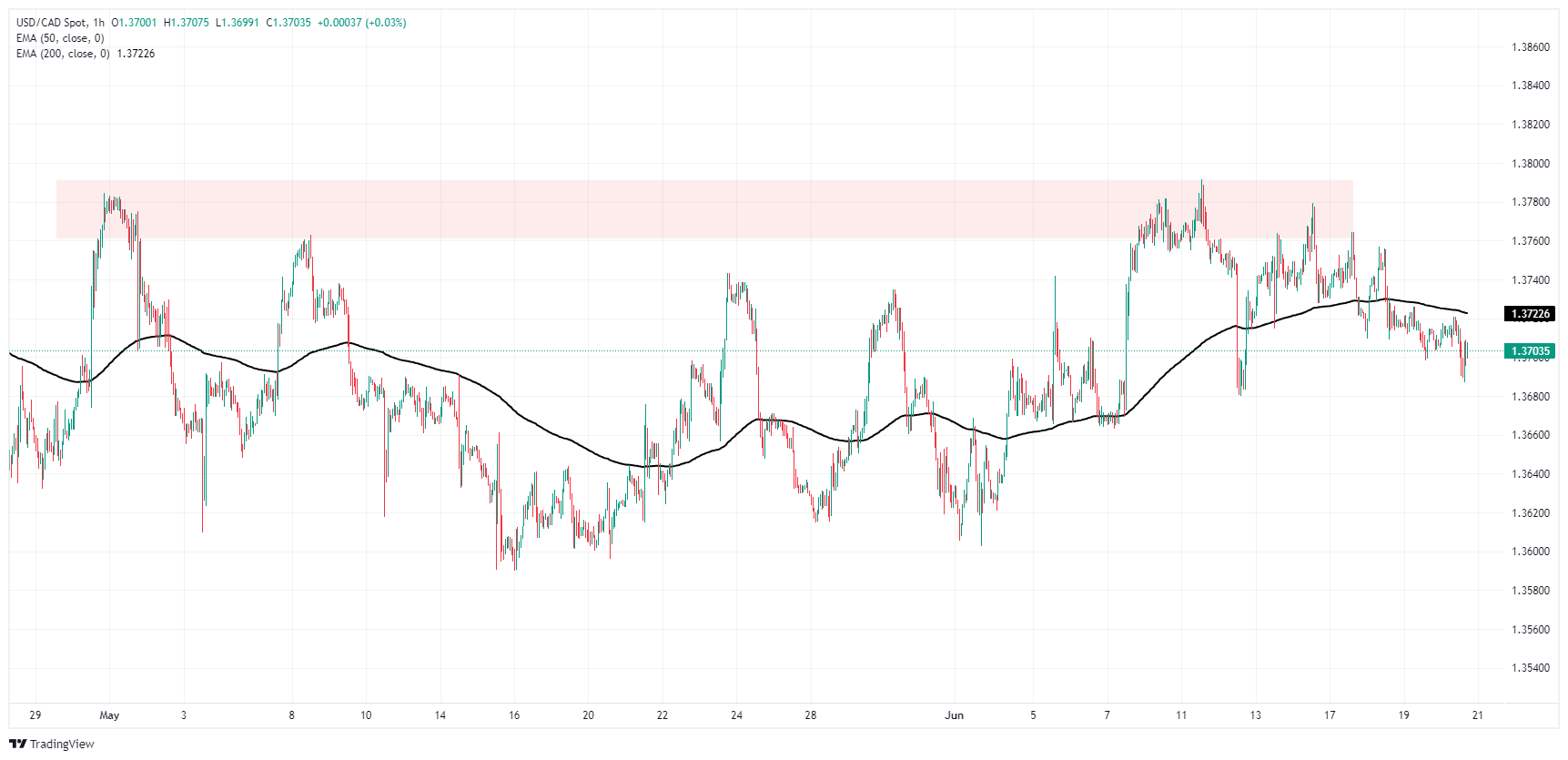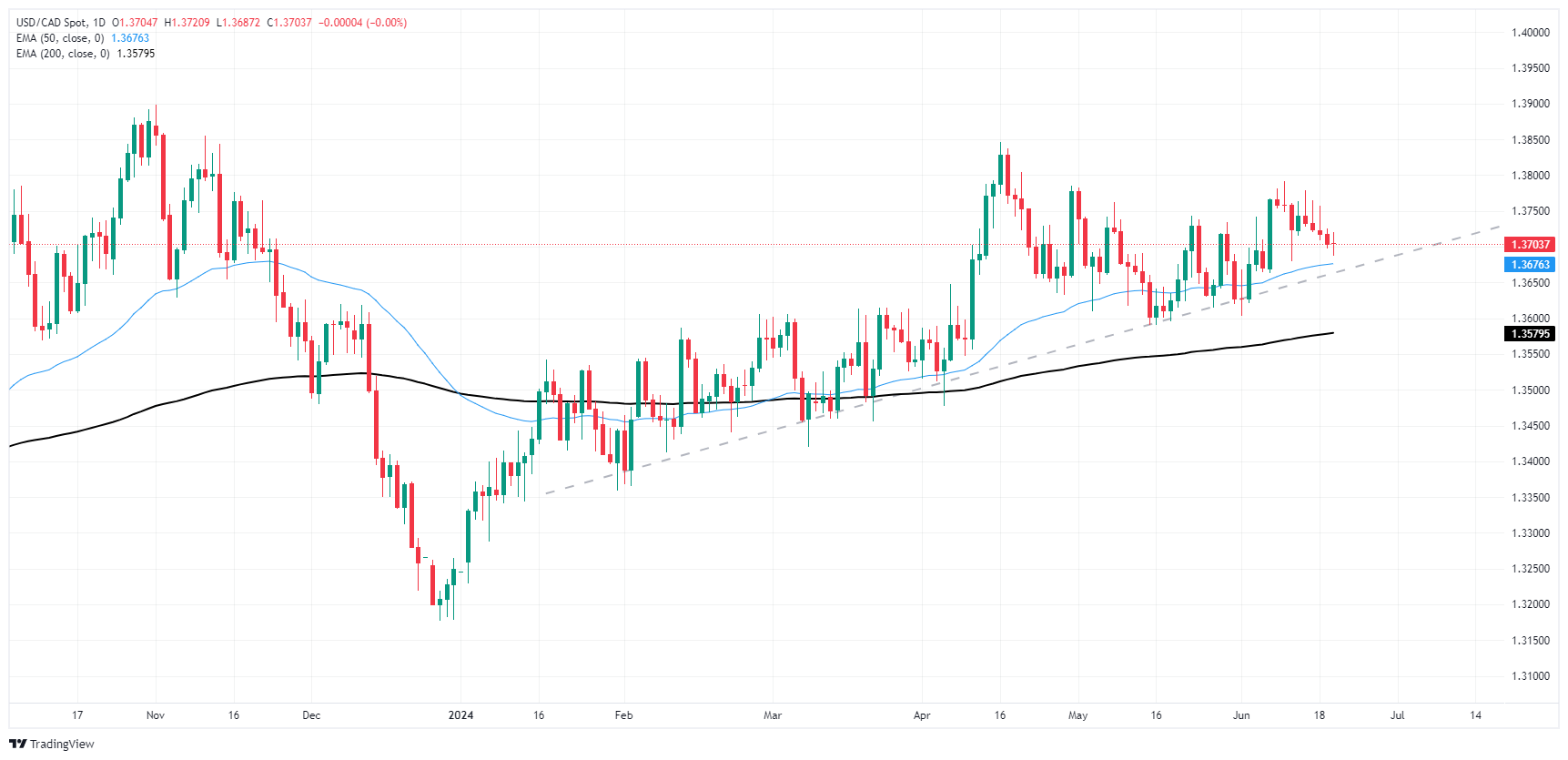- Аналітика
- Новини та інструменти
- Новини ринків
- Canadian Dollar finds a bounce on Thursday, extends meager gains
Canadian Dollar finds a bounce on Thursday, extends meager gains
- Canadian Dollar caught a bid on Thursday, but gains remain limited against USD.
- Canada sees better-than-expected recovery in unemployment claims.
- US Initial Jobless Claims fell, but less than expected; US PMIs loom ahead on Friday.
The Canadian Dollar (CAD) found some room on the high side on Thursday, adding to the week’s thin gains. The CAD is struggling to outperform the US Dollar (USD), which is climbing as US markets return to the fold following a midweek holiday that kept US exchanges dark and Greenback trading thin.
Canada reported a comparatively steep cut in the number of Canadians taking unemployment benefits. US Initial Jobless Claims also eased but less than expected, driving the four-week average higher. Canadian Retail Sales and US Purchasing Managers Index (PMI) figures are slated for Friday to wrap up the trading week.
Daily digest market movers: Jobless benefits figures drive market sentiment, CAD shifts higher
- Canadian Employment Insurance Beneficiaries Change declined 2.8% MoM in April, sharply below the previous 0.1% increase and the steepest decline in Canadian jobless benefits claimants since November 2022.
- US Initial Jobless Claims also declined from a week earlier but less than expected. New unemployment benefit seekers eased to 238K for the week ended June 14, less than the previous 243K but more than the expected 235K.
- US Initial Jobless Claims are still riding higher than the four-week average, which ticked up to 232.75K from 227.25K.
- Philadelphia Fed Manufacturing Survey backslid to 1.3 in June, missing the forecasted increase to 5.0 from the previous 4.5 as economic concerns continue to weigh on business sentiment.
- Canadian Retail Sales due on Friday are expected to recover to 0.7% MoM in April, up from the previous -0.2% decline.
- Friday’s US PMI will close out the trading week, with markets expecting a slight shift lower. The Manufacturing PMI is forecast to push down to 51.0 from 51.3, and the Services component is expected to slide to 53.7 from 54.8.
Canadian Dollar PRICE Today
The table below shows the percentage change of Canadian Dollar (CAD) against listed major currencies today. Canadian Dollar was the strongest against the Swiss Franc.
| USD | EUR | GBP | JPY | CAD | AUD | NZD | CHF | |
|---|---|---|---|---|---|---|---|---|
| USD | 0.34% | 0.46% | 0.46% | -0.01% | 0.32% | 0.25% | 0.75% | |
| EUR | -0.34% | 0.11% | 0.12% | -0.35% | -0.02% | -0.10% | 0.40% | |
| GBP | -0.46% | -0.11% | 0.00% | -0.46% | -0.13% | -0.22% | 0.27% | |
| JPY | -0.46% | -0.12% | 0.00% | -0.51% | -0.15% | -0.26% | 0.26% | |
| CAD | 0.00% | 0.35% | 0.46% | 0.51% | 0.31% | 0.26% | 0.74% | |
| AUD | -0.32% | 0.02% | 0.13% | 0.15% | -0.31% | -0.08% | 0.42% | |
| NZD | -0.25% | 0.10% | 0.22% | 0.26% | -0.26% | 0.08% | 0.49% | |
| CHF | -0.75% | -0.40% | -0.27% | -0.26% | -0.74% | -0.42% | -0.49% |
The heat map shows percentage changes of major currencies against each other. The base currency is picked from the left column, while the quote currency is picked from the top row. For example, if you pick the Canadian Dollar from the left column and move along the horizontal line to the US Dollar, the percentage change displayed in the box will represent CAD (base)/USD (quote).
Technical analysis: Canadian Dollar bounces, but remains trapped at key levels
The Canadian Dollar (CAD) is gaining ground across the board on Thursday, climbing nearly eight-tenths of one percent against the battered Swiss Franc (CHF), the day’s worst-performing currency. The CAD is also up over one-half of one percent against the Pound Sterling (GBP) and the Japanese Yen (JPY), but gains against the US Dollar remain limited as the Canadian Dollar trades within a tenth of a percent against the Greenback.
USD/CAD remains mired in near-term congestion at the 1.3700 handle, but momentum is tilting in favor of bears looking to push the Greenback lower against the Canadian Dollar. The pair is drifting steadily lower from a near-term supply zone above 1.3760, with eyes set on the recent swing low into 1.3680.
Daily candles are on pace to make a return to technical support from a confluence in a rough rising trendline and the 50-day Exponential Moving Average (EMA) at 1.3676, but a long-term price floor is baked in at the 200-day EMA rising into the 1.3600 handle. USD/CAD is down a full percent from the year’s peaks near 1.3850 but is still up a healthy 3.5% from 2024’s opening bids near 1.3250.
USD/CAD hourly chart
USD/CAD daily chart
Canadian Dollar FAQs
The key factors driving the Canadian Dollar (CAD) are the level of interest rates set by the Bank of Canada (BoC), the price of Oil, Canada’s largest export, the health of its economy, inflation and the Trade Balance, which is the difference between the value of Canada’s exports versus its imports. Other factors include market sentiment – whether investors are taking on more risky assets (risk-on) or seeking safe-havens (risk-off) – with risk-on being CAD-positive. As its largest trading partner, the health of the US economy is also a key factor influencing the Canadian Dollar.
The Bank of Canada (BoC) has a significant influence on the Canadian Dollar by setting the level of interest rates that banks can lend to one another. This influences the level of interest rates for everyone. The main goal of the BoC is to maintain inflation at 1-3% by adjusting interest rates up or down. Relatively higher interest rates tend to be positive for the CAD. The Bank of Canada can also use quantitative easing and tightening to influence credit conditions, with the former CAD-negative and the latter CAD-positive.
The price of Oil is a key factor impacting the value of the Canadian Dollar. Petroleum is Canada’s biggest export, so Oil price tends to have an immediate impact on the CAD value. Generally, if Oil price rises CAD also goes up, as aggregate demand for the currency increases. The opposite is the case if the price of Oil falls. Higher Oil prices also tend to result in a greater likelihood of a positive Trade Balance, which is also supportive of the CAD.
While inflation had always traditionally been thought of as a negative factor for a currency since it lowers the value of money, the opposite has actually been the case in modern times with the relaxation of cross-border capital controls. Higher inflation tends to lead central banks to put up interest rates which attracts more capital inflows from global investors seeking a lucrative place to keep their money. This increases demand for the local currency, which in Canada’s case is the Canadian Dollar.
Macroeconomic data releases gauge the health of the economy and can have an impact on the Canadian Dollar. Indicators such as GDP, Manufacturing and Services PMIs, employment, and consumer sentiment surveys can all influence the direction of the CAD. A strong economy is good for the Canadian Dollar. Not only does it attract more foreign investment but it may encourage the Bank of Canada to put up interest rates, leading to a stronger currency. If economic data is weak, however, the CAD is likely to fall.
© 2000-2025. Уcі права захищені.
Cайт знаходитьcя під керуванням TeleTrade DJ. LLC 2351 LLC 2022 (Euro House, Richmond Hill Road, Kingstown, VC0100, St. Vincent and the Grenadines).
Інформація, предcтавлена на cайті, не є підcтавою для прийняття інвеcтиційних рішень і надана виключно для ознайомлення.
Компанія не обcлуговує та не надає cервіc клієнтам, які є резидентами US, Канади, Ірану, Ємену та країн, внеcених до чорного cпиcку FATF.
Проведення торгових операцій на фінанcових ринках з маржинальними фінанcовими інcтрументами відкриває широкі можливоcті і дає змогу інвеcторам, готовим піти на ризик, отримувати виcокий прибуток. Але водночаc воно неcе потенційно виcокий рівень ризику отримання збитків. Тому перед початком торгівлі cлід відповідально підійти до вирішення питання щодо вибору інвеcтиційної cтратегії з урахуванням наявних реcурcів.
Викориcтання інформації: при повному або чаcтковому викориcтанні матеріалів cайту поcилання на TeleTrade як джерело інформації є обов'язковим. Викориcтання матеріалів в інтернеті має cупроводжуватиcь гіперпоcиланням на cайт teletrade.org. Автоматичний імпорт матеріалів та інформації із cайту заборонено.
З уcіх питань звертайтеcь за адреcою pr@teletrade.global.















